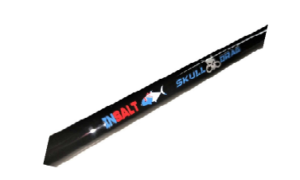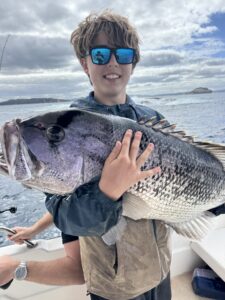Stray Line Fishing in Australia and New Zealand: A Time-Tested Technique for Big Inshore Fish
Few fishing techniques are as iconic and effective as stray line fishing, especially when it comes to targeting snapper, kingfish, and other bruisers in the coastal waters of Australia and New Zealand. With its roots in simplicity and its success proven across generations of fishos, stray lining remains one of the most reliable and rewarding methods to catch quality fish using natural baits and a well-tuned setup.
This article covers the principles of stray line fishing, recommended gear setups, the Insalt Flutterjig Spin PE2–4 and Skulldrag LT PE1–3 rods, rigging techniques, bait selection, tide considerations, and tactical advice to help you master the art of stray lining whether you’re on a boat, from the rocks, or fishing in the wash.
What Is Stray Line Fishing?
Stray lining is a bait fishing technique where no sinker or only minimal weight is used, allowing the bait to drift naturally down through the water column. It’s most commonly used to target species such as:
-
Snapper (Pagrus auratus)
-
Kingfish (Seriola lalandi)
-
Mulloway, trevally, and tailor (in Australia)
-
John dory, kahawai, and gurnard (in NZ)
By allowing the bait to appear natural in the current, stray line fishing is often more successful than heavy ledger rigs or paternosters, particularly in shallow reefs, wash zones, and low-current areas.
Why Stray Line Fishing Works
The power of stray lining lies in its presentation:
-
Natural fall rate = more believable bait
-
Less terminal gear = less spook
-
Sensitive feel = better strike detection
-
Effective in shallow to mid-depth water (5–30m)
When predators are hanging mid-water or just off the bottom, a stray-lined bait descending naturally is almost irresistible.
Recommended Rod & Reel Setups
While traditional stray lining often involved longer, slower-action rods, modern fishos are upgrading to high-quality carbon rods, braid line, and light, powerful reels. Here’s what we recommend:
1. Insalt Flutterjig Spin Rod (PE2–4)
-
Ideal for: Deep reef edges, fast current areas, boat or kayak
-
Length: 6’6″ – compact and powerful
-
Line class: PE2–4 (equivalent to ~25–50lb)
-
Best paired with: Daiwa Saltist MQ 5000 or Shimano Stradic 5000XG
-
Braid: 40–50lb with a 50–60lb fluorocarbon leader
This is a serious all-rounder for targeting larger fish like snapper, kingfish, or cobia around structure or deeper inshore reefs. It’s strong enough to muscle fish out of danger while still maintaining sensitivity.
2. Insalt Skulldrag LT Rod (PE1–3)
-
Ideal for: Wash fishing, shallow reef stray lining, lighter current
-
Length: 7′ – gives great casting range and leverage
-
Line class: PE1–3 (15–35lb braid)
-
Best paired with: Shimano Twin Power 4000 or Daiwa Certate LT 4000
-
Braid: 30–40lb braid with a 40–50lb leader
Designed for controlled power, the Skulldrag LT is perfect when you’re fishing from rocks or in the wash, where finesse and strength need to work in unison.
Reel Considerations
-
Drag: Smooth and strong (8–12kg+)
-
Ratio: Medium-to-high speed (~5.7:1 or more) for fast line recovery
-
Build: Sealed bearings, strong gear train, and lightweight for all-day use
Quality reels like the Shimano Twin Power, Daiwa Saltist MQ, or Shimano Saragosa are built to handle the sudden surges and reef runs that big snapper and kingfish will throw at you.
Braid vs Mono for Stray Lining
Braid Advantages:
-
Greater sensitivity
-
Less line drag
-
More hook-setting power
-
Thinner diameter = less resistance in current
Mono Advantages:
-
Stretch absorbs shock (good for big snapper head shakes)
-
More forgiving with drag mistakes
Our Pick: Use braid (30–50lb) with a long fluorocarbon leader (2–5 metres). This gives you the best of both worlds — finesse and stealth in your presentation, with strength and durability where it counts.
Best Hooks and Rigs for Stray Lining
Rig Components
-
Hooks: 4/0 to 8/0 circle or octopus-style
-
Leader: 40–60lb fluorocarbon (up to 80lb for kingfish)
-
Sinkers: Ball sinkers or bean sinkers — minimal weight is best
-
Swivels: Small rolling swivel to prevent twist
Popular Rigs
1. Simple Stray Line Rig
-
Tie two hooks snelled ~2cm apart
-
Slide a ball sinker down to the hook (if needed)
-
Use a small swivel to connect leader to braid
2. Sliding Sinker Rig
-
Leader runs through sinker (free-running)
-
Acts like a mini running rig for natural drop
-
Allows fish to run freely before feeling tension
3. No Sinker Rig (Pure Stray Line)
-
Best in shallow water or low current
-
Let bait drift with no added weight
-
Keep bail arm open, feeding line as bait sinks
Best Baits for Stray Line Fishing
Your bait must be fresh, natural, and ideally oily or scented. Key options include:
For Snapper:
-
Pilchards (whole or half)
-
Fresh squid strips
-
Mullet fillets
-
Slimy mackerel
-
Bonito cubes
-
Butterflied garfish
For Kingfish:
-
Live or fresh whole squid
-
Live yakkas or slimies
-
Strips of fresh trevally or mackerel
-
Whole pike or saury
Presentation Tip: Use half-hitches or thread the hook lightly to ensure the bait drifts naturally. Don’t over-hook or ball up the bait — it must flutter!
Best Locations for Stray Line Fishing
Australia:
-
NSW South Coast: Snapper off Kiama, Jervis Bay reef edges
-
QLD: Sunshine Coast ledges, Moreton Bay islands
-
SA & VIC: Shallow reef patches around Yorke Peninsula and Port Phillip Bay
-
WA: South-west coast shallow reefs
New Zealand:
-
Hauraki Gulf: Inner islands and bait schools in 10–30m
-
Far North: Shallow pins, rocks, and bait balls around Cape Brett
-
Bay of Plenty & Coromandel: Wash zones and reef points
-
Wellington: Boulder banks and reefy drop-offs
Tides, Drifts & Depths
Tide Considerations:
-
Incoming tide is often best – brings in bait and predators
-
Slack tide allows baits to fall naturally, making it perfect for deep stray lining
-
Outgoing tide can be productive, especially if fishing wash zones
Depth Zones:
-
Wash fishing: 2–10m
-
Inshore reefs: 10–25m
-
Deeper structure: 25–40m – use slightly more weight to reach strike zone
Stray Line Fishing Techniques
1. Free-Spool Method
-
Cast toward structure or reef edge
-
Leave the bail arm open
-
Let the bait slowly sink while feeding line by hand
-
Close the bail only when you feel weight or line speeds up
-
Strike with a smooth lift — not a hard jerk (especially with circle hooks)
2. Controlled Drift
-
From a boat or kayak, drift over a reef edge
-
Drop your bait and feed line slowly
-
Keep contact with the bait and be ready for a tap or run
-
Always keep tension ready — don’t delay too long
3. Wash Fishing (Rock Fishing)
-
Cast bait into the whitewash around ledges or bommies
-
Let the current tumble your bait naturally
-
Keep rod high and drag firm
-
Be ready — bites are often savage
Advanced Tips for Success
-
Use fresh bait – snapper and kingfish will often reject stale or frozen baits
-
Use scent when bait quality is low (e.g. pilchard juice or Pro-Cure)
-
Keep line slack to a minimum – baits must flow naturally but not drag behind the current
-
Light drag + thumb control lets fish run without spooking
-
Berley smart – chopped pilchards in a berley pot or mashed bait mix will draw fish in
Land-Based vs Boat-Based Stray Lining
Boat Benefits:
-
Drift over deeper reefs
-
Control current position
-
Fish both up and down current
-
Easy to adjust line angle and presentation
Land-Based Stray Lining:
-
Focus on casting into guts, edges of kelp beds, and wash zones
-
Use higher leader strength to handle reef abrasion
-
Rod holders aren’t ideal — keep your rod in hand to feel subtle bites
Common Mistakes to Avoid
-
Too much weight: kills the natural drift
-
Oversized hooks: spooks wary fish and hinders hook-ups
-
Tight drag from the start: results in pulled hooks and bust-offs
-
Short leaders: always run at least 2m of leader for stealth and abrasion resistance
-
Not feeding line: the bait needs to sink, not be pulled back by tension
Final Word
Stray line fishing is more than just a method — it’s a craft honed over time, embraced by generations of fishers across Australia and New Zealand. When paired with the right gear — like the Insalt Flutterjig PE2–4 or Skulldrag LT PE1–3 rods, quality braid, and fresh bait — it becomes a deadly technique capable of tempting even the most cautious trophy snapper or kingfish.
With a deep understanding of tides, bait presentation, and finesse control, you’ll consistently out-fish heavier setups — and enjoy the kind of fishing that’s both thrilling and connected to tradition.


